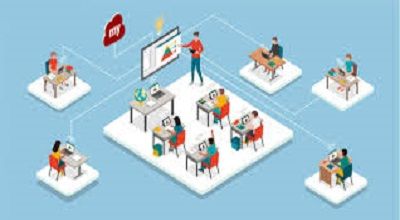Remote Learning:
Remote learning refers to a mode of education where students and teachers interact and engage in learning activities without being physically present in the same location. It often involves the use of digital technologies and online platforms to deliver lessons, assignments, and assessments. In remote learning, students can access educational materials, participate in discussions, submit assignments, and receive feedback from their teachers using the internet and various communication tools.
Online Learning:
Online learning is a form of education that takes place entirely over the Internet. It involves accessing educational content, resources, and activities through online platforms and tools. Online courses can be asynchronous, meaning students can access the materials at their own pace and time, or synchronous, involving real-time interactions between students and instructors through webinars, video conferencing, or chat sessions. Online learning is flexible and allows students to learn from anywhere with an internet connection.
Hybrid Learning:
Hybrid learning, also known as blended learning, combines elements of both traditional in-person instruction and online learning. In a hybrid learning environment, students engage in a mix of face-to-face interactions with instructors and peers, as well as online activities and assignments. The balance between in-person and online components can vary; for instance, some classes might meet in person on specific days and have online activities on others. Hybrid learning aims to leverage the benefits of both in-person and online learning, offering flexibility while maintaining some level of personal interaction.
In summary:
- Remote learning involves education without physical presence using digital tools.
- Online learning is entirely web-based, with students accessing content and activities online.
- Hybrid learning combines in-person and online components to provide flexibility and interaction.
- Features Of Remote, Online, & Hybrid Learning
Here are some key features of remote, online, and hybrid learning:
1:Remote Learning:
- Location Independence: Students and instructors can participate in learning activities from different locations using internet-connected devices.
- Digital Tools: Remote learning relies on digital technologies, including online platforms, video conferencing, and communication tools, to facilitate instruction and collaboration.
- Flexibility: Students often have more flexibility in terms of when and where they engage with learning materials, allowing them to adapt their schedules to their needs.
- Asynchronous Communication: Communication and engagement can occur asynchronously, meaning participants don’t need to be online at the same time.
- Challenges: Lack of face-to-face interaction and potential feelings of isolation can be challenges in remote learning. Technical issues and the need for self-discipline are also considerations.
2: Online Learning:
- Internet-Based: All learning activities, including accessing content, interacting with instructors and peers, and submitting assignments, are conducted over the Internet.
- Self-Paced Learning: Many online courses offer self-paced learning, allowing students to progress through the material at their own speed.
- Wide Accessibility: Online courses can be accessed from anywhere, making education accessible to people regardless of their geographic location.
- Variety of Formats: Online learning can encompass various formats, such as video lectures, discussion forums, quizzes, and interactive simulations.
- Autonomy: Students need strong self-motivation and time-management skills to succeed in online courses.
3: Hybrid Learning:
- Flexibility and Face-to-Face Interaction: Hybrid learning offers a blend of in-person and online components, providing flexibility while maintaining some level of face-to-face interaction.
- Customization: Instructors can design learning experiences that capitalize on the strengths of both in-person and online instruction.
- Balanced Learning: Hybrid courses aim to balance the benefits of personal interaction with the convenience and flexibility of online learning.
- Varied Activities: In-person sessions might include group discussions, hands-on activities, and demonstrations, while online components can include readings, videos, and online assessments.
- Technology Integration: Successful hybrid learning requires effective integration of technology tools to ensure a seamless transition between in-person and online activities.
Each of these learning approaches has its own strengths and challenges, and the choice of which one to use depends on the educational goals, resources, and preferences of both instructors and learners.
